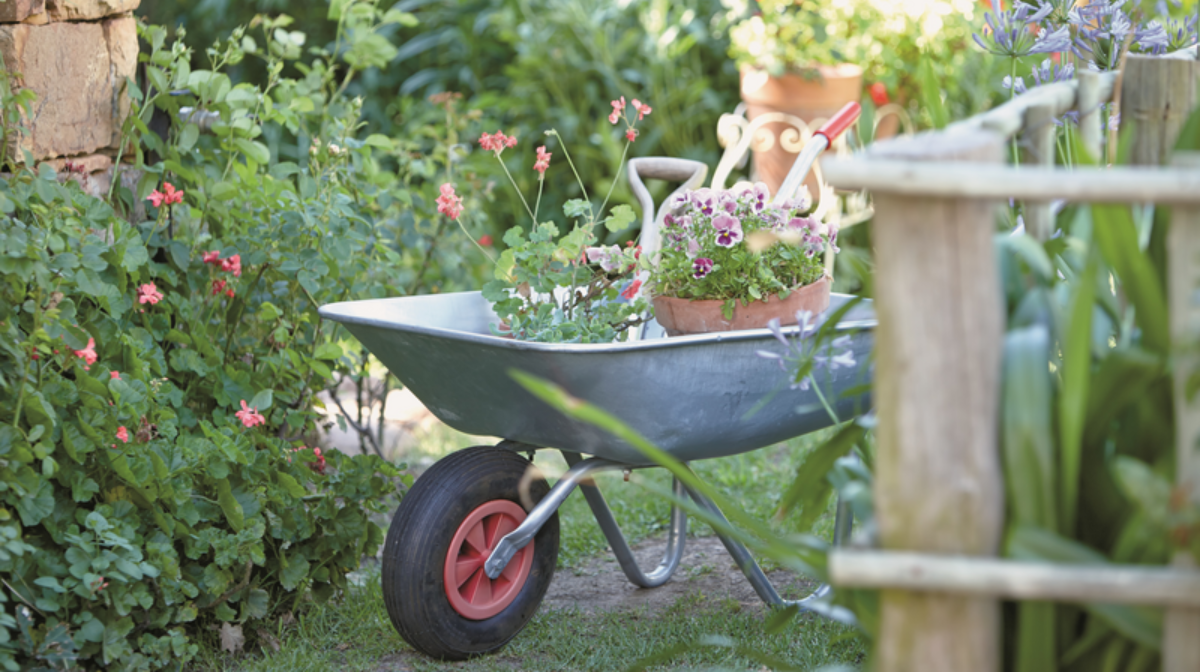Where’s the best place to live in the UK if you want to be a gardener?
The British have a long-standing love affair with their gardens, with gardening as a pastime deeply ingrained in British culture and history.
As a country, we have a rich tradition of hands-on horticulture, from stately homes to terraced houses, our gardening heritage dates back centuries. We’ve even been known on occasion to get a little bit competitive about it!
With this in mind, Homebase has created the British Gardening Index, to establish exactly where in the country is best for gardening.
What is an index, we hear you ask? Well, it’s a combination of different factors which, when looked at together, give an outlook on how something performs. In this case, we’ve looked at five key factors that make a place perfect for being a gardener.
Those five factors were:
- Soil fertility
- Percentage of homes with gardens
- Average square metres per garden
- Number of garden centres in the area
- Local enthusiasm for gardening
Each factor was given a maximum score out of 10, for a total possible score of 50.
According to our index, there are three regions in the UK tied for first place! Those lucky winners were Guildford in Surrey, Chorley in Lancashire and Sevenoaks in Kent, which all scored an impressive 30 points.
Soil Fertility
Soil fertility refers to soil’s ability to provide essential nutrients to plants in order to support their growth.
Fertile soil contains the right mix of micronutrients that plants need to thrive. In addition to providing nutrients, it must also have good soil structure, texture, and water-holding capacity, to ensure that plants can access the nutrients.
For the UK’s top areas for soil fertility, nine towns & cities in the UK came out on top for having highly fertile soil, with a few of them having very distinct reasons for why that is!
The soil in Kettering, for example, is primarily composed of Northamptonshire boulder clay, which is high in both nutrients and organic matter. This dates back to the last Ice Age when glaciers that covered the local area created a mix of minerals and nutrients vital for healthy plants.
In Maidstone, the soil is primarily composed of a mix of clay, sand, and loam. Kent is situated on a bed of chalk, which is rich in calcium – essential for plant growth. Chalk also has brilliant water-retention properties, helping to keep thirsty plants well-hydrated.
The soil in Harlow is also a nutritious mix of clay, sand, and loam. However, it is the Limestone which Essex rests on that is the secret to surprisingly fertile soil. Limestone, much like chalk, is rich in calcium and other key minerals that plants crave.
The UK towns & cities with the most fertile soil
- Guildford, Surrey
- Kettering, Northamptonshire
- Maidstone, Kent
- Gloucester, Gloucestershire
- Daventry, Northamptonshire
- Sutton, Surrey
- Harlow, Essex
- Luton, Bedfordshire
- Milton Keynes, Buckinghamshire
The average soil fertility for UK towns and cities is actually low. Of course, you don’t have to rely on nature for this, thankfully. If the natural soil fertility in your area is low, you can always replace it with organic fertile soil that is primed and ready for growing all manner of plants and vegetables!
Number of Gardens
It goes without saying that, to be a gardener, you’ve got to have a garden in the first place!
Though not everyone in the UK has a garden, we have looked hard at the numbers to determine where in the UK homes have the most gardens. According to our research, an average of 9 in 10 UK residents have access to a private garden – and some are even higher than that!
Middlesbrough and Rotherham are two such regions that scored highly on this, both in Yorkshire! Firstly, Yorkshire is a large and diverse region, with a mix of urban, suburban, and rural areas. Many people in the region may have access to outdoor space, including gardens, due to the relatively lower cost of living in some parts of Yorkshire compared to other regions in the UK.
Secondly, Yorkshire has a long history of agriculture and horticulture, with many people in the region having an interest in gardening and growing their own food. There are also several well-known public gardens and horticultural attractions in Yorkshire, such as Harlow Carr in Harrogate and the Yorkshire Arboretum in York, which may inspire people to take up gardening as a hobby.
The UK towns & cities with the highest percentage of gardens
- Middlesbrough, North Yorkshire – 95.6%
- Rotherham, South Yorkshire – 95.0%
- Chesterfield, Derbyshire – 95.0%
In any of these areas, 19 out of 20 people have access to a private garden of their own.
Average Size of Garden
When it comes to gardens, the more space you have, the more plants you can fit in!
The average size of a private garden in Britain can vary greatly depending on the location and type of property. For the towns and cities in the UK, the average size of a garden is approximately 289 square metres. However, some are much larger.
The UK towns & cities with the biggest gardens
- Sevenoaks, Kent – 713 square metres
- Chichester, West Sussex – 707 square metres
- Horsham, West Sussex – 650 square metres
It is fitting that the UK’s biggest gardens can be found in Sevenoaks. After all, they don’t call Kent the ‘Garden of England’ for nothing. The average size of a garden in Kent is 713 Square Metres, almost three times as much as the national average!
Second and third places were taken by Chichester, 707 square Metres, and Horsham, 650 square metres, both in West Sussex. The climate in West Sussex, much like Kent, is generally mild, with plenty of sunshine and rainfall, which is conducive to growing a wide range of plants.
Number of Garden Centres
The garden centre is a beloved destination for many Brits on a weekend.
From plants, bulbs, seeds and gardening tools to outdoor furniture and decor, there is something for everyone, and – come early spring – it feels like the entire nation descends on them to get their garden summer ready!
You’re rarely ever too far from a garden centre in the UK. In fact, the average number of local garden centres was 21!
However, Devon is known for having a higher concentration of garden centres than most areas.
Devon’s natural climate, with its balmy summers and mild winters, makes it an ideal location for gardening and horticulture.
This has created a huge demand for gardening supplies and plants in the area, which has led to the development of many garden centres for its local population, many of whom have gardens or allotments and are keen gardeners.
The UK counties with the most garden centres
- Devon – 42
- Dorset – 33
- Gloucestershire – 33
Exeter and Plymouth came out on top here, being the only two places in the UK from Devon featured in this study.
Most Enthusiastic Gardeners
Gardening is usually a solitary activity, but – having said that – living in a community where gardeners are aplenty is a great way to talk about your favourite subject – and maybe get some tips too!
To ascertain the country’s most enthusiastic gardeners, Homebase looked at the online demand for gardening products in certain regions and divided that by the local population.
The greatest demand for garden products per population was in Croydon in Surrey, followed by Birmingham and Walsall in the West Midlands.
Both Croydon and the West Midlands have a diverse population and a mix of urban and rural areas. While those in the more rural areas are likely to have gardens to tend to, those in more urban areas, where land is at a premium, might not.
Those without traditional gardens have found alternative means to indulge in their passion for horticulture, whether that be cultivating balcony gardens or joining community garden schemes or leasing allotments.
The UK towns & cities with the most enthusiastic gardeners
- Croydon, Surrey
- Birmingham, West Midlands
- Walsall, West Midlands
Methodology
Rankings given to each town & city were scored from 0-10 on a gradient. The top score for each category would receive 10 points, and then subsequent points would be based on a percentage of that figure. Scores out of a possible 50.
Data for the seven ranking factors were taken from the following sources:
- Soil Fertility – Soilscapes by the Cranfield Soil and Agrifood Institutes.
- Homes with Gardens & Average Garden Size – Access to gardens and public green space in Great Britain by the Office for National Statistics (ONS).
- Garden Centres – Where are Britain’s garden centres concentrated by Hortweek.
- Gardening Enthusiasm – A score calculated by dividing total search volume for gardening-related phrases from Keyword Tool.io by local population of the area.
Some UK towns and cities were not included due to data not being available on them for any of the 5 factors.
The full dataset detailing specific information for each town & city is available for the press upon request.
| Rank | Town/City | County | Soil Fertility | Homes with Gardens | Average Garden Size | Garden Centres | Gardening Enthusiasm | Total Score (out of 50) |
| 1 | Guildford | Surrey | 10 | 4 | 8 | 5 | 3 | 30 |
| 1 | Chorley | Lancashire | 8 | 8 | 5 | 4 | 5 | 30 |
| 1 | Sevenoaks | Kent | 4 | 6 | 10 | 5 | 5 | 30 |
| 4 | Kettering | Northamptonshire | 10 | 6 | 4 | 4 | 5 | 29 |
| 4 | Maidstone | Kent | 10 | 3 | 6 | 5 | 5 | 29 |
| 4 | Tewkesbury | Gloucestershire | 4 | 5 | 7 | 7 | 6 | 29 |
| 7 | Gloucester | Gloucestershire | 10 | 7 | 2 | 7 | 2 | 28 |
| 7 | Colchester | Essex | 8 | 4 | 6 | 5 | 5 | 28 |
| 7 | Winchester | Hampshire | 8 | 3 | 8 | 4 | 5 | 28 |
| 7 | Warrington | Cheshire | 6 | 7 | 3 | 7 | 5 | 28 |
| 11 | Boston | Lincolnshire | 6 | 8 | 6 | 4 | 3 | 27 |
| 11 | Stafford | Staffordshire | 6 | 6 | 6 | 4 | 5 | 27 |
| 11 | Stroud | Gloucestershire | 6 | 5 | 8 | 7 | 1 | 27 |
| 11 | Chichester | West Sussex | 4 | 5 | 9 | 4 | 5 | 27 |
| 15 | Daventry | Northamptonshire | 10 | 3 | 6 | 4 | 3 | 26 |
| 15 | Horsham | West Sussex | 8 | 4 | 9 | 4 | 1 | 26 |
| 15 | Fareham | Hampshire | 6 | 8 | 5 | 4 | 3 | 26 |
| 15 | Chesterfield | Derbyshire | 4 | 9 | 3 | 7 | 3 | 26 |
| 15 | Lichfield | Staffordshire | 4 | 7 | 6 | 4 | 5 | 26 |
| 15 | Brentwood | Essex | 4 | 5 | 7 | 5 | 5 | 26 |
| 21 | York | North Yorkshire | 8 | 7 | 3 | 4 | 3 | 25 |
| 21 | Tunbridge Wells | Kent | 8 | 3 | 8 | 5 | 1 | 25 |
| 21 | Middlesbrough | North Yorkshire | 6 | 10 | 2 | 4 | 3 | 25 |
| 21 | Carlisle | Cumbria | 6 | 8 | 5 | 3 | 3 | 25 |
| 21 | Dover | Kent | 6 | 6 | 5 | 5 | 3 | 25 |
| 21 | Cheltenham | Gloucestershire | 6 | 6 | 3 | 7 | 3 | 25 |
| 21 | Harrogate | North Yorkshire | 6 | 6 | 7 | 4 | 2 | 25 |
| 21 | Scarborough | North Yorkshire | 6 | 6 | 5 | 4 | 4 | 25 |
| 21 | Dartford | Kent | 6 | 6 | 3 | 5 | 5 | 25 |
| 21 | Walsall | West Midlands | 6 | 6 | 3 | 4 | 6 | 25 |
| 21 | Maldon | Essex | 6 | 5 | 8 | 5 | 1 | 25 |
| 21 | Warwick | Warwickshire | 6 | 5 | 5 | 3 | 6 | 25 |
| 21 | Rotherham | South Yorkshire | 4 | 9 | 3 | 4 | 5 | 25 |
| 21 | Plymouth | Devon | 4 | 6 | 2 | 10 | 3 | 25 |
| 21 | Stockport | Cheshire | 4 | 6 | 3 | 7 | 5 | 25 |
| 21 | Ashford | Kent | 4 | 3 | 8 | 5 | 5 | 25 |
| 37 | Sutton | Surrey | 10 | 4 | 3 | 5 | 2 | 24 |
| 37 | Rochdale | Lancashire | 6 | 7 | 2 | 4 | 5 | 24 |
| 37 | Gateshead | Tyne & Wear | 6 | 6 | 2 | 5 | 5 | 24 |
| 37 | Basildon | Essex | 6 | 5 | 5 | 5 | 3 | 24 |
| 37 | Barnsley | South Yorkshire | 4 | 8 | 3 | 4 | 5 | 24 |
| 37 | Dudley | West Midlands | 4 | 8 | 3 | 4 | 5 | 24 |
| 37 | Eastleigh | Hampshire | 4 | 6 | 5 | 4 | 5 | 24 |
| 37 | Stirling | Stirlingshire | 4 | 5 | 7 | 4 | 4 | 24 |
| 37 | Braintree | Essex | 4 | 5 | 7 | 5 | 3 | 24 |
| 37 | Falkirk | Stirlingshire | 4 | 5 | 5 | 4 | 6 | 24 |
| 37 | Canterbury | Kent | 4 | 4 | 6 | 5 | 5 | 24 |
| 48 | St Albans | Hertfordshire | 8 | 2 | 5 | 4 | 4 | 23 |
| 48 | Corby | Northamptonshire | 6 | 8 | 2 | 4 | 3 | 23 |
| 48 | Mansfield | Nottinghamshire | 6 | 8 | 3 | 4 | 2 | 23 |
| 48 | Great Yarmouth | Norfolk | 6 | 7 | 3 | 4 | 3 | 23 |
| 48 | Wellingborough | Northamptonshire | 6 | 6 | 3 | 4 | 4 | 23 |
| 48 | Derby | Derbyshire | 6 | 5 | 2 | 7 | 3 | 23 |
| 48 | Wolverhampton | West Midlands | 6 | 5 | 3 | 4 | 5 | 23 |
| 48 | Bury | Lancashire | 4 | 8 | 2 | 4 | 5 | 23 |
| 48 | Exeter | Devon | 4 | 4 | 2 | 10 | 3 | 23 |
| 57 | Harlow | Essex | 10 | 2 | 2 | 5 | 3 | 22 |
| 57 | Crawley | West Sussex | 8 | 6 | 2 | 4 | 2 | 22 |
| 57 | Sunderland | Tyne & Wear | 6 | 9 | 1 | 5 | 1 | 22 |
| 57 | Newcastle upon Tyne | Tyne & Wear | 6 | 4 | 2 | 5 | 5 | 22 |
| 57 | Peterborough | Cambridgeshire | 4 | 8 | 3 | 2 | 5 | 22 |
| 57 | Tamworth | Staffordshire | 4 | 7 | 2 | 4 | 5 | 22 |
| 57 | Thanet | Kent | 4 | 7 | 3 | 5 | 3 | 22 |
| 57 | Havant | Hampshire | 4 | 6 | 3 | 4 | 5 | 22 |
| 57 | Chelmsford | Essex | 4 | 4 | 6 | 5 | 3 | 22 |
| 57 | Croydon | Surrey | 4 | 2 | 1 | 5 | 10 | 22 |
| 57 | Woking | Surrey | 2 | 7 | 6 | 5 | 2 | 22 |
| 68 | Hastings | East Sussex | 8 | 4 | 3 | 4 | 2 | 21 |
| 68 | Swindon | Wiltshire | 6 | 6 | 2 | 4 | 3 | 21 |
| 68 | Stoke-on-Trent | Staffordshire | 4 | 9 | 2 | 4 | 2 | 21 |
| 68 | Wigan | Lancashire | 4 | 8 | 2 | 4 | 3 | 21 |
| 68 | Wokingham | Berkshire | 4 | 6 | 6 | 2 | 3 | 21 |
| 68 | Oldham | Lancashire | 4 | 6 | 2 | 4 | 5 | 21 |
| 68 | Bedford | Bedfordshire | 4 | 6 | 5 | 1 | 5 | 21 |
| 68 | Bolton | Lancashire | 4 | 6 | 2 | 4 | 5 | 21 |
| 68 | Wakefield | West Yorkshire | 4 | 5 | 3 | 4 | 5 | 21 |
| 68 | Solihull | West Midlands | 4 | 5 | 5 | 4 | 3 | 21 |
| 68 | Rochford | Essex | 4 | 4 | 6 | 5 | 2 | 21 |
| 68 | Rugby | Warwickshire | 4 | 3 | 6 | 3 | 5 | 21 |
| 80 | Luton | Bedfordshire | 10 | 4 | 2 | 1 | 3 | 20 |
| 80 | Lincoln | Lincolnshire | 6 | 4 | 2 | 4 | 4 | 20 |
| 80 | Lewes | East Sussex | 6 | 3 | 6 | 4 | 1 | 20 |
| 80 | Conwy | Gwynedd | 4 | 6 | 6 | 2 | 2 | 20 |
| 80 | Northampton | Northamptonshire | 4 | 6 | 2 | 4 | 4 | 20 |
| 80 | Birmingham | West Midlands | 4 | 3 | 3 | 4 | 6 | 20 |
| 80 | Doncaster | South Yorkshire | 2 | 8 | 3 | 4 | 3 | 20 |
| 87 | Milton Keynes | Buckinghamshire | 10 | 3 | 2 | 1 | 3 | 19 |
| 87 | Blackpool | Lancashire | 6 | 6 | 1 | 4 | 2 | 19 |
| 87 | Eastbourne | East Sussex | 6 | 3 | 3 | 4 | 3 | 19 |
| 87 | Isle of Wight | Isle of Wight | 4 | 5 | 6 | 2 | 2 | 19 |
| 91 | Cambridge | Cambridgeshire | 6 | 2 | 3 | 2 | 5 | 18 |
| 91 | Burnley | Lancashire | 4 | 8 | 1 | 4 | 1 | 18 |
| 91 | Kingston upon Hull | East Riding of Yorkshire | 4 | 7 | 1 | 4 | 2 | 18 |
| 91 | Ipswich | Suffolk | 4 | 4 | 3 | 5 | 2 | 18 |
| 91 | Bradford | West Yorkshire | 4 | 3 | 2 | 4 | 5 | 18 |
| 91 | Leeds | West Yorkshire | 4 | 3 | 2 | 4 | 5 | 18 |
| 91 | Salford | Lancashire | 4 | 3 | 2 | 4 | 5 | 18 |
| 98 | Oxford | Oxfordshire | 6 | 2 | 2 | 4 | 3 | 17 |
| 98 | Caerphilly | Vale of Glamorgan | 4 | 8 | 2 | 1 | 2 | 17 |
| 98 | Lancaster | Lancashire | 4 | 3 | 3 | 4 | 3 | 17 |
| 101 | Reading | Berkshire | 6 | 3 | 3 | 2 | 2 | 16 |
| 101 | Sheffield | South Yorkshire | 4 | 3 | 2 | 4 | 3 | 16 |
| 101 | Leicester | Leicestershire | 4 | 3 | 2 | 4 | 3 | 16 |
| 101 | Coventry | West Midlands | 4 | 3 | 2 | 4 | 3 | 16 |
| 101 | Stevenage | Hertfordshire | 4 | 3 | 2 | 4 | 3 | 16 |
| 101 | Worthing | West Sussex | 4 | 3 | 3 | 4 | 2 | 16 |
| 101 | Southend-on-Sea | Essex | 4 | 3 | 2 | 5 | 2 | 16 |
| 101 | Nottingham | Nottinghamshire | 4 | 2 | 2 | 4 | 4 | 16 |
| 101 | Aberdeen | Aberdeenshire | 4 | 2 | 3 | 4 | 3 | 16 |
| 101 | Norwich | Norfolk | 4 | 2 | 2 | 4 | 4 | 16 |
| 101 | Glasgow | Lanarkshire | 4 | 2 | 3 | 3 | 4 | 16 |
| 112 | Newport | Monmouthshire | 4 | 4 | 3 | 3 | 1 | 15 |
| 112 | Swansea | Vale of Glamorgan | 4 | 4 | 4 | 1 | 2 | 15 |
| 112 | Preston | Lancashire | 4 | 3 | 2 | 4 | 2 | 15 |
| 112 | Liverpool | Merseyside | 4 | 3 | 1 | 4 | 3 | 15 |
| 112 | Slough | Berkshire | 4 | 2 | 2 | 2 | 5 | 15 |
| 112 | Manchester | Greater Manchester | 4 | 1 | 1 | 4 | 5 | 15 |
| 118 | Portsmouth | Hampshire | 4 | 3 | 1 | 4 | 2 | 14 |
| 118 | Southampton | Hampshire | 4 | 2 | 2 | 4 | 2 | 14 |
| 118 | Watford | Hertfordshire | 4 | 1 | 2 | 4 | 3 | 14 |
| 121 | Cardiff | Vale of Glamorgan | 4 | 3 | 2 | 1 | 2 | 12 |










